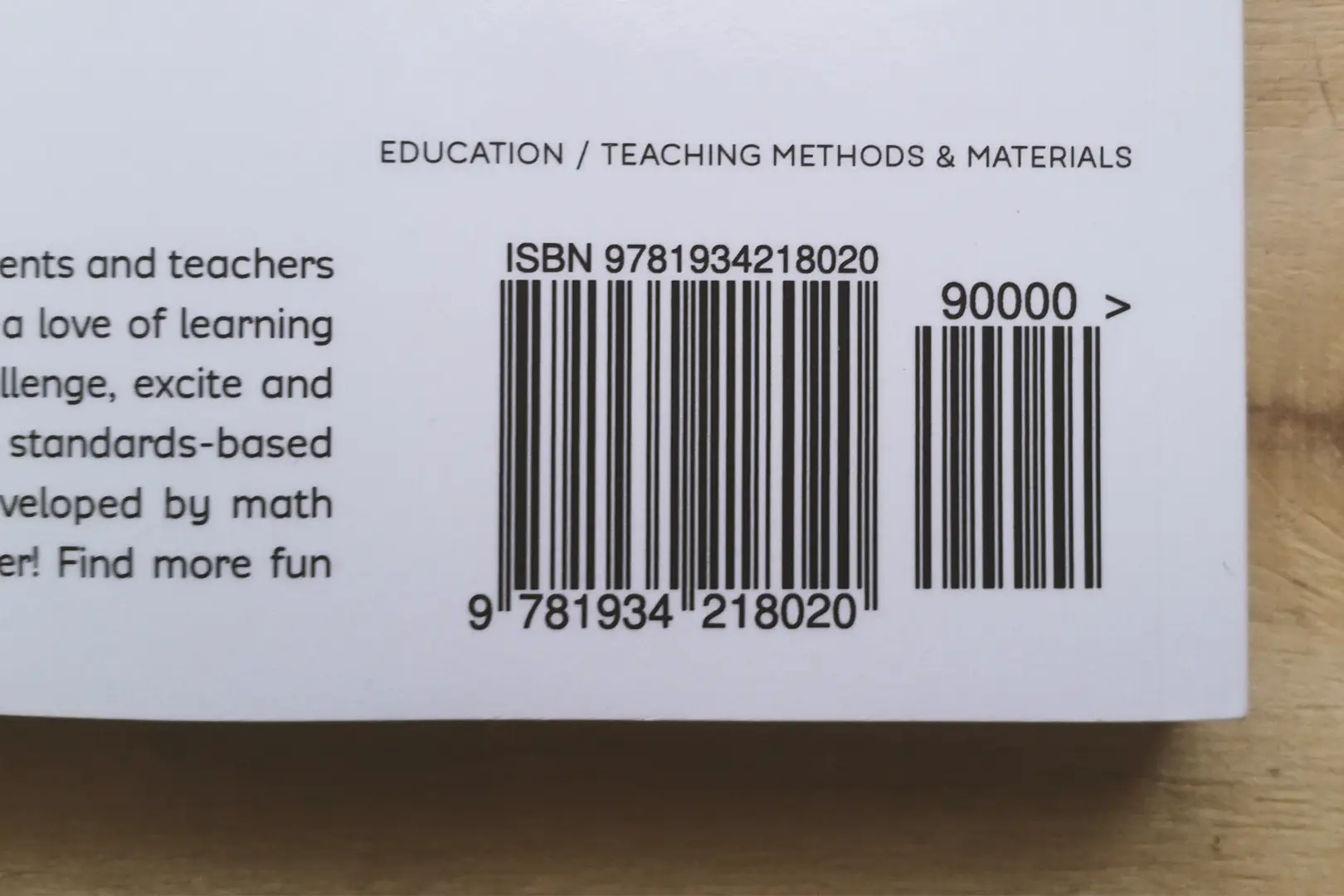Barcodes and 2D Codes in Education
Historical Usage of Barcodes in Education
Barcodes have been part of education infrastructure since the late 20th century. Libraries were pioneers: as early as the 1970s, they began using 1D barcodes to automate cataloging and lending. An early barcode format called Codabar (introduced 1972) was quickly adopted by libraries to speed up check-outs and returns (The history of Codabar barcode) (The history of Codabar barcode). By the mid-1980s, academic libraries in the US were transitioning from card catalogs to barcode-based systems. For example, Oakland University’s library in Michigan started barcoding its entire book collection in 1986, completing the process by February 1987 (Timeline - OU Libraries). This automation allowed books and patron library cards to carry unique barcode labels, vastly improving inventory accuracy and lending speed. European libraries followed a similar trajectory: in the UK, some libraries experimented with the Telepen barcode (a high-density code) in the late 1980s to streamline book tracking (The history of Telepen barcode in libraries). Early 1990s saw wider implementation of barcodes across UK and EU libraries, reflecting a general move to modernize library systems (The history of Telepen barcode in libraries).
Outside libraries, educational institutions gradually applied barcodes to student identification and administrative tasks. Campus ID cards evolved from simple photo IDs to multi-purpose “smart” cards.
By 1985, Duke University (US) had implemented a campus-wide system that incorporated a barcode on each student ID alongside magnetic stripes (Campus card - Wikipedia). Scanning these barcoded IDs enabled faster access to dorms, dining halls, and library checkouts, replacing manual ID checks.
In the 1990s, many US and European universities adopted similar barcode-enhanced IDs as part of one-card systems. School administrative offices also found uses for barcodes—tracking student records, processing paperwork, and managing fees. For instance, barcodes began appearing on transcripts, applications, and test forms to uniquely identify documents and students, reducing errors in record-keeping. By the early 2000s, K–12 schools were using barcoded systems to manage textbook distribution and student files, cutting down on lost items and speeding up audits (a response to significant losses in school assets each year (How to Get Started with Barcoding at Your School) (How to Get Started with Barcoding at Your School)).
(Timeline - OU Libraries) Early library automation: Librarians in the 1980s using a handheld barcode scanner to catalog books. Libraries were among the first in education to adopt barcodes, replacing the old card-based systems.
Current Implementations in Education
Today, barcodes and two-dimensional (2D) codes (like QR Code, DataMatrix, PDF417) are ubiquitous across educational institutions in both the US and EU. They play a critical role in day-to-day operations spanning libraries, identification, attendance, exams, and asset management.
Libraries – Inventory and Self-Service
Modern school and university libraries rely on barcodes for efficient inventory management and circulation. Virtually every book in a library is tagged with a unique barcode (often Code 39 or Code 128 format) that links to its catalog record. When a patron borrows or returns a book, staff or self-service kiosks scan the book’s barcode to instantly update the digital catalog.
This system allows precise tracking of a book’s status and location, ensures accurate loan records, and helps manage overdue items. For example, each library book at a university carries a barcode on the cover or inside cover; scanning it at checkout logs the borrower and due date in seconds. Many libraries have introduced self-checkout stations where students swipe their ID card and scan book barcodes themselves. This speeds up service and frees librarians for other tasks. At Yale University’s libraries, students can even use a mobile self-checkout app: after logging in, they scan the book’s barcode with their phone camera to check it out without staff assistance (Self-Checkout App | Yale Library). Such self-service barcode systems have minimized wait times and made borrowing more convenient. Barcodes are also used to manage library materials beyond books – journals, DVDs, and equipment all carry scannable codes so that the library’s entire collection is digitally cataloged and searchable.
Notably, some libraries are beginning to supplement or replace barcodes with RFID tags for faster bulk scanning, but barcodes remain a cost-effective standard due to their simplicity and reliability (Two Ways AI-Driven Smart Technologies Are Helping the Libraries) (Two Ways AI-Driven Smart Technologies Are Helping the Libraries). Libraries that implemented barcode systems report greater accuracy in shelving and inventory audits, since every item’s movement is logged by a scan instead of paper records.
Student & Staff Identification
Educational institutions issue ID cards to students, faculty, and staff that increasingly feature machine-readable codes. In many cases, a 1D or 2D barcode is printed on the ID card, tying the card to the individual’s record in campus databases. Scanning the barcode on an ID allows for rapid identity verification and access to services. For instance, a student can swipe or scan their ID’s barcode to enter a secured building, check out library books, or verify their attendance at an exam. A common practice in US schools is to use ID badges with barcodes for cafeteria payments and library checkout – one scan debits the student’s meal plan or logs a borrowed book (The Barcode as a Mark of the Beast Resurfaces in Texas | The New Republic).
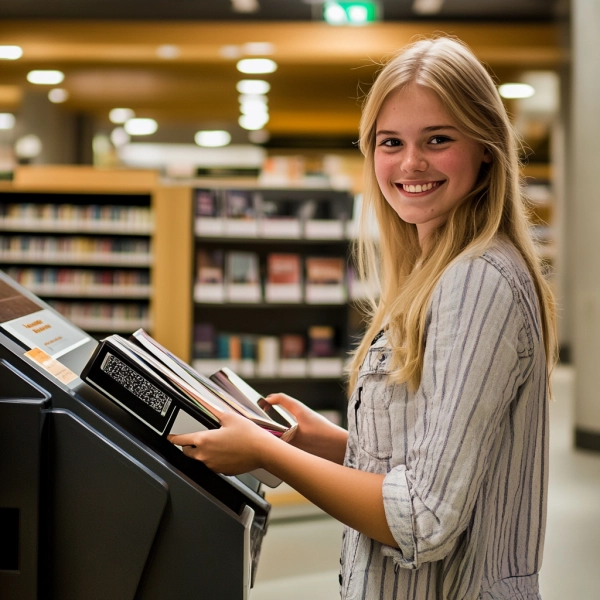
In the EU, universities often deploy unified multi-function IDs. The Berlin area’s CampusCard is an example: a single student card doubles as library card and dining hall payment card (with a barcode or chip linking to the student’s accounts) (Campuscard • Education • Freie Universität Berlin) (Campuscard • Education • Freie Universität Berlin). Scanning a CampusCard at the library issues a loan, while the same card at a cafeteria register pulls up the student’s prepaid balance. Some institutions use 2D codes on IDs to encode more data securely – for example, PDF417 barcodes (a stacked code symbology) appear on certain university ID cards to store student ID numbers, names, and other info in a machine-readable block. These high-density codes allow offline verification (useful if network access to the database is down) and can incorporate error-correction. Similarly, DataMatrix codes (a square 2D code) are used when space is limited or additional encryption is desired; they might be printed on the back of an ID card or a parking permit for quick scanning. Whether 1D or 2D, barcoded IDs have become integral to campus life: tapping a card on a scanner at the gym, library, or dorm is far faster than manual check-ins. The convenience does come with a responsibility to safeguard data – most systems ensure that the barcode itself carries only a student number or token, and personal details are pulled from secure databases after scanning (to comply with privacy laws like FERPA and GDPR).
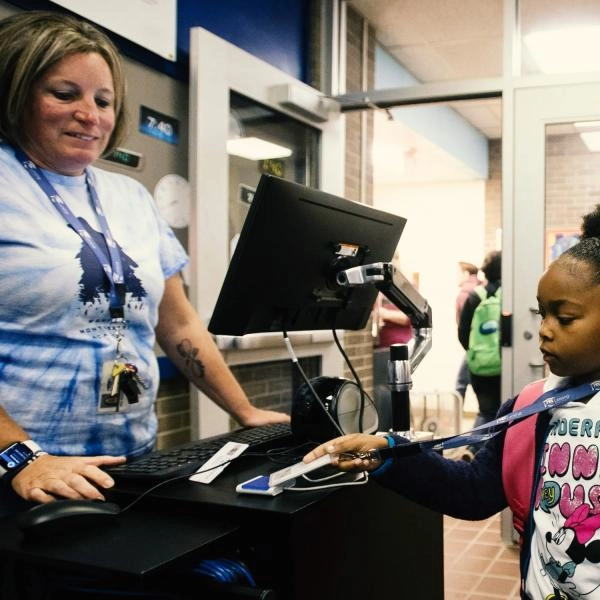
Real-world implementations abound: for example, Texas’s Northside School District issues ID cards with barcodes that students scan to buy lunch and check out books, replacing the need to carry cash or separate library cards (The Barcode as a Mark of the Beast Resurfaces in Texas | The New Republic). In Europe, the new European Student Card initiative is pushing universities to include a standardized QR code on all student IDs, so that a quick scan can verify a student’s status across any EU campus (). This shows how barcoded IDs are now seen as key to interoperability and ease of access for students.
Attendance Tracking
Barcode scanning has largely replaced manual attendance roll calls in many schools and universities. Instead of calling names or passing sign-in sheets, instructors and administrators use barcode-based systems to record who is present. A typical setup issues each student a unique barcode (often on their ID card or a printed pass). When arriving at class, the student either taps their ID on a scanner at the door or the teacher uses a mobile device to scan the barcode on each ID. The scan instantly logs the student’s attendance (with timestamp) in the system, eliminating the need for paper logs. This approach greatly improves speed and accuracy: for example, an instructor can take attendance for a 100-student lecture in seconds as students walk in and flash their ID barcodes.
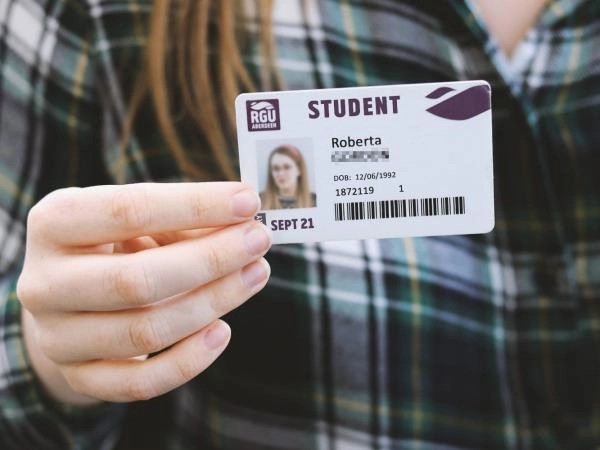
Some schools have installed attendance kiosks – e.g. a tablet at the classroom entrance where students scan the barcode on their ID or even a QR code from a mobile app. The data goes straight into attendance software, which can flag absences or tardies automatically and even notify parents if needed. One case is a high school that gave teachers handheld barcode scanners to check students into each class; teachers reported far less class time wasted and immediate attendance records available for administrators (Take Attendance with a Barcode Scanner | CLASS Help Center).
In higher education, large universities use similar methods for events like freshman orientation or exam sessions, scanning IDs to track attendance and ensure only authorized students are present. During the COVID-19 pandemic, many institutions also adopted contactless QR code check-ins for both health screening and attendance. For instance, the University of Maryland placed QR codes on classroom seats – students would scan the code at their seat with a phone, logging their presence along with seating location (Classroom QR codes boost contact tracing at U. Maryland | EdScoop) (Classroom QR codes boost contact tracing at U. Maryland | EdScoop).
This not only recorded attendance but also fed into contact-tracing systems. The success of such systems showed that QR codes and barcodes can handle attendance even in non-traditional settings (like remote learning check-ins or study hall tracking). Schools have found that digitizing attendance reduces fraud (students can’t easily sign in for an absent friend when a unique scan is required) and saves staff hours of administrative work. However, best practices dictate that these systems be privacy-conscious – for example, only storing scan records as long as necessary and not using location data beyond the intended purpose (Classroom QR codes boost contact tracing at U. Maryland | EdScoop).
Exam Security and Integrity
Barcodes and 2D codes play a crucial role in securing examinations and maintaining academic integrity. In many universities, exam papers, answer sheets, or even student admission tickets are printed with barcodes/QR codes to ensure proper identification and tracking. A common procedure is for each exam paper or booklet to carry a unique code that links it to a specific student or seat. Before an exam, students often must scan their ID card or a personalized exam entry barcode to confirm their identity and check into the exam session (Mobile Barcode Scanners: Education). This prevents imposters – the system immediately flags if an ID scan doesn’t match an expected student for that exam.
During large exams, proctors might issue different test versions and use barcodes to track which version each student received. For example, each question booklet could have a barcode that is scanned and assigned to a student ID at distribution, so the system knows who has version A, B, etc. This makes it harder for students to cheat by copying, since neighbors will have different versions, and it allows investigators to trace any leaked or missing booklet by its code (Mobile Barcode Scanners: Education) (Mobile Barcode Scanners: Education). Throughout the exam process, mobile barcode scanners are used to monitor exam materials. Proctors might scan the barcode on each answer sheet as they collect them, instantly logging that John Doe turned in his paper and preventing lost exams (Mobile Barcode Scanners: Education). If an answer sheet is misplaced, administrators can identify it by its code and know which student’s work is missing. After exams, barcodes aid in grading security: for standardized tests, it’s common that answer sheets have a barcode with the student’s ID or registration number.
Grading machines or staff scan these to ensure scores are correctly attributed. Some universities employ anonymized grading – they replace student names with barcode IDs on exam booklets so graders don’t know whose paper they are marking (reducing bias). Only after grading are the codes matched back to student identities. Additionally, barcodes help detect tampering: a tamper-evident label with a code may seal a packet of exam questions; if the seal is broken and the code doesn’t scan as intact, officials know the packet was opened prematurely.
In professional testing centers and certification exams (which many students take), PDF417 2D barcodes are often on the test tickets or candidate IDs. These can encode the candidate’s details and exam data in one scan, streamlining check-in and adding layers of verification. Overall, from verifying identities at the door to tracking exam papers and automating scoring, barcode technology has significantly tightened exam security. Administrators note reduced incidents of misplaced exams and impersonation when these systems are in place (Mobile Barcode Scanners: Education) (Mobile Barcode Scanners: Education). The combination of unique identifiers and automation creates a clear chain-of-custody for exam materials, which is crucial for maintaining trust in the examination process.
Asset & Inventory Management
Educational institutions own vast amounts of property – library books, yes, but also lab equipment, computers, projectors, musical instruments, sports gear, and more. Managing these assets is a daunting task without automation, and this is where barcodes and QR codes provide a simple, low-cost inventory control solution.
Many K-12 school districts and universities have implemented barcode-based asset tracking systems to keep tabs on everything from textbooks to tablets. Each item receives an asset tag (often a sticker or metal label) printed with a barcode or QR code that encodes a unique asset ID. Using handheld scanners or even smartphone apps, staff can scan items during inventories or check-out/check-in procedures. This practice dramatically improves accuracy in asset audits.
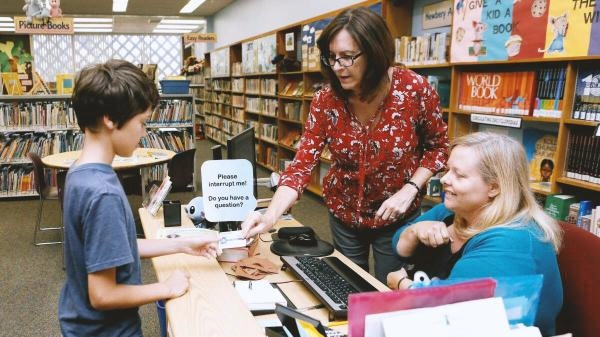
For example, West Briar Middle School in Houston (USA) struggled with manual tracking of hundreds of computers and devices, leading to frequent lost equipment. They adopted a comprehensive barcode asset management system in 2010: all school-owned technology was tagged with barcoded labels and logged in a database (School Asset Tracking Case Study: Houston ISD - Wasp Barcode). Technicians and teachers then scanned items when assigning them to classrooms or for maintenance. As a result, the school could account for every laptop and projector, eliminating unnecessary replacements of “lost” gear and saving tight budget funds (School Asset Tracking Case Study: Houston ISD - Wasp Barcode) (School Asset Tracking Case Study: Houston ISD - Wasp Barcode).
Similarly, in the EU, universities often use barcodes/QR codes to manage laboratory inventories – e.g. microscopes and chemicals in a science lab are tagged and scanned each time they are moved or used, providing a digital trail. Textbook tracking is another critical application: Schools issue textbooks to students and record it by scanning the book’s barcode along with the student’s ID barcode. This creates a link so that at year’s end, administrators can scan returned books and know who still hasn’t turned theirs in.
Large districts have saved millions by reducing lost textbooks this way, as one audit in Los Angeles showed tens of thousands of dollars in books were simply misplaced in storage until a barcode system revealed them (How to Get Started with Barcoding at Your School) (How to Get Started with Barcoding at Your School).
Asset tracking via barcodes also extends to newer initiatives like 1:1 device programs (where each student gets a Chromebook or tablet). Schools label each device with a barcode/QR and scan them when assigning devices to students, so there’s clear accountability. University facilities departments use barcode inventories for furniture, art, and even keys. A quick scan can tell an administrator which classroom a piece of equipment belongs in, or when a computer was last serviced. QR codes are increasingly used here because they can be scanned easily with smartphones (no dedicated scanner needed) and can encode a URL for more information. For instance, scanning a QR code sticker on a school’s 3D printer might open a maintenance log or an online form to report issues. Both US and EU institutions are embracing such systems. In the UK, some schools are using smartphone apps to scan asset QR codes into cloud-based databases, combining GPS data to know where the scan happened (useful for tracking mobile equipment) (How to Get Started with Barcoding at Your School) (How to Get Started with Barcoding at Your School). The result of these efforts is better stewardship of resources: fewer items go missing, maintenance is scheduled on time, and audits that once took weeks can be done in days with automated scanning. As one education technology provider summarized, barcodes and QR codes offer a cost-effective way to “tag” every school asset and minimize loss, especially important as budgets remain tight (How to Get Started with Barcoding at Your School).
(Common barcode types used in education include Code 39 and Code 128 for books and equipment, Codabar for older library systems, QR Codes for quick mobile scanning, DataMatrix for small items like lab samples, and PDF417 for high-data applications like student IDs.)
Future Trends and Innovations
Integration with AI and Smart Systems
Looking ahead, the coupling of barcode/QRCodes with artificial intelligence (AI) promises to further enhance efficiency and decision-making in education. One trend is using AI-driven computer vision to read barcodes and even recognize objects without human intervention. For instance, smart inventory robots in libraries could navigate shelves, scan book barcodes automatically, and use AI to detect if an item is mis-shelved or missing. AI algorithms are already helping libraries optimize operations – as noted by the American Library Association, librarians are exploring how AI can aid in “discoverability” of materials and automate routine tasks (Two Ways AI-Driven Smart Technologies Are Helping the Libraries).
Barcodes (and their RFID successors) are a key enabler: they provide the data points that AI systems consume to make decisions. A clear example is automated materials handling in large libraries or school districts. AI-powered sorting machines can scan the barcode on a returned book, identify where it should go, and route it to the correct bin or shelf, all without staff input (Two Ways AI-Driven Smart Technologies Are Helping the Libraries) (Two Ways AI-Driven Smart Technologies Are Helping the Libraries). The combination of barcodes and AI reduces manual sorting errors and speeds up reshelving. We also see AI in predictive analytics using barcode data. Schools accumulate a lot of scan data (library checkouts, cafeteria sales by scanning IDs, attendance swipes, etc.).

Machine learning can analyze these patterns to make predictions – for example, predicting library traffic at certain times (to adjust staffing) or identifying which textbooks are least used and could be phased out. In terms of security, AI may be used alongside barcode-based ID checks to bolster identity verification. One can envision an exam check-in where a student’s ID barcode is scanned while an AI facial recognition system simultaneously confirms the student’s face – creating a two-factor authentication for exams. (Some universities have piloted facial recognition for attendance or entry, though this raises privacy concerns). Another emerging idea is AI tutoring via QR codes: a student might scan a QR code in a textbook and be connected to an AI tutor or explanation for that concept. The QR acts as a quick link, and the AI provides the interactive teaching. This blend of physical materials with AI-driven digital content could become more common in smart textbooks and augmented reality learning experiences. While these integrations are nascent, the groundwork is being laid with the proliferation of codes on educational materials. Essentially, barcodes and QR codes provide a bridge from physical to digital, and AI is set to make that bridge even more powerful by automating responses once a code is scanned (be it fetching information, updating records, or making decisions).
As AI and computer vision improve, we might even see a future where physical barcodes become less visible – cameras could recognize books or ID cards by appearance – but the concept of a machine-readable identifier, which barcodes pioneered, will remain central. Schools embracing AI will still rely on some form of tagging (1D, 2D code or more advanced) to give machines a hook into their inventory of people and objects. In summary, AI stands to turn barcode data into smarter actions: imagine an AI system flagging an equipment shortage because it notices from barcode scans that certain lab kits are checked out continuously, or an AI librarian that can answer a student’s question by linking the scanned ISBN barcode of a book to relevant online resources. These innovations are on the horizon, and pilot programs are already exploring them.
Blockchain Credentials and Verification
In the realm of credentials and record-keeping, blockchain technology combined with QR codes is poised to transform how academic achievements are verified. Both in the US and Europe, universities are experimenting with issuing diplomas, certificates, and transcripts that include secure QR codes linked to blockchain records. The idea is to combat credential fraud and make verification instant. A blockchain is essentially a tamper-proof ledger; when a university issues a degree, it can record a hash or ID of that degree on a blockchain. The graduate then gets a diploma (physical or digital) with a QR code that encodes a link or ID to that blockchain record. Any employer or institution can simply scan the QR code on the certificate, and a verification portal will automatically confirm the degree’s authenticity against the blockchain data (Blockchain for Credential Verification: A Game-Changer in the Education Sector). This means no more time-consuming background checks or falsifiable paper transcripts – the verification is trustless and immediate. In practice, this trend has already begun: Johns Hopkins University (US) recently added a QR-coded “Surety Lock™” watermark on the back of its printed diplomas (as of October 2024) (University Registrar). Scanning that QR code produces real-time confirmation of the graduate’s name, degree, and conferral date from the university’s secure records, effectively acting as a digital notary of the diploma (University Registrar). On a broader scale, companies like Blockcerts and projects under the European Commission are developing standards for blockchain-backed education credentials. The EU’s Europass Digital Credentials framework enables institutions to issue diplomas with embedded QR codes that verify against a decentralized ledger, aligning with the European approach to data privacy and portability. One outcome is that students will truly “own” their credentials – they might carry a digital wallet with verifiable copies of all their achievements, which they can showcase by allowing someone to scan a QR code. We are also seeing secure transcript systems: instead of a sealed paper transcript, a university can provide a PDF with a QR code that any recipient can scan to verify grades via blockchain. Beyond degrees, this approach is being used for qualifications like MOOC certificates, professional training credits, even micro-credentials and badges. For students, this trend promises easier sharing of their accomplishments across borders (no need to request a new transcript for each application). For schools, it drastically cuts down verification requests and enhances their reputation by preventing fake diplomas in their name (Blockchain for Credential Verification: A Game-Changer in the Education Sector) (Blockchain for Credential Verification: A Game-Changer in the Education Sector). Another future use-case is linking exam integrity to blockchain: for example, logging each step of an exam lifecycle (creation, administration, results) on a blockchain and using QR codes on exam documents to verify that process. While that is still experimental, it could eliminate any doubts about grades or question paper leaks by providing an immutable audit trail. In summary, blockchain plus QR codes is creating “digital diplomas” that can be trusted globally. As one tech firm describes, a recruiter can just scan the QR on a candidate’s e-diploma and immediately see it verified on-chain, with no third-party in between (Blockchain for Credential Verification: A Game-Changer in the Education Sector). We can expect more universities in the US and EU to adopt this as best practice, especially as the workforce and academic mobility become more international and demand quick, reliable credential checks.
Mobile & Contactless Innovations
The COVID-19 pandemic accelerated the adoption of contactless technologies in education, and many of those changes are here to stay. QR codes, in particular, saw a resurgence as a hygienic, touch-free way to share information – and schools leveraged this in various ways. One notable trend is using QR codes to distribute digital content and assignments. Instead of handing out papers, a teacher can display a QR code on the board; students scan it with their smartphones or tablets and are taken directly to an online assignment, PDF, or quiz. This method has become popular in both K-12 and higher ed because it’s fast and error-free (no typos in a long URL). Educators have compiled many creative classroom uses for QR codes: for instance, embedding codes in a worksheet that link to explanatory videos or interactive exercises, setting up scavenger hunts where each clue is accessed by scanning a code, or facilitating quick surveys and exit tickets via QR-linked Google Forms (9 awesome ways to use QR codes for the classroom - The ESL Educator) (9 awesome ways to use QR codes for the classroom - The ESL Educator).
These practices make learning more engaging and accessible – if a student needs enrichment, they can scan a code to get optional material; if they missed class, scanning the posted QR might give them a recap or recording. In remote and hybrid learning scenarios, QR codes served as a convenient bridge between physical and virtual. Professors have used QR codes during Zoom lectures (shared on screen) so students can scan with their phone to register attendance or answer a poll while watching on their computer. Similarly, schools stuck QR codes on lab equipment or outside classrooms that students could scan to pull up cleaning protocols or schedules, minimizing the need to ask someone in person. Another surge in contactless tech is digital student IDs on mobile phones. Many universities in the US, including Duke and the University of Alabama, now let students add their campus ID to Apple Wallet or Google Wallet (Six universities shake up their student IDs with new Apple Wallet integration | EdScoop) (Six universities shake up their student IDs with new Apple Wallet integration | EdScoop). With a digital ID, a student simply holds up their iPhone or smartwatch to a reader to enter buildings or pay at campus dining – essentially an NFC tap. But even without NFC, these digital ID apps often include a QR code or barcode that can be scanned as an alternative. For example, a campus security officer could scan the QR code in a student’s mobile ID app to verify it if needed. This mobile convergence means students don’t have to carry a separate plastic card; their phone becomes their key and wallet. It’s more secure (phones can be locked/tracked) and in line with students’ expectations for convenience.
Some European universities are also adopting mobile IDs or integrating student ID functions into existing national digital ID frameworks. Contactless QR codes are also enhancing campus navigation and access to resources. “Scan for info” has become a common sight: A university library might place a QR code on a study room door – scan it to see how to reserve the room. Or a campus tour might use QR codes at stops where prospective students can scan to watch a short video about that facility. In the post-pandemic period, contactless check-ins remain popular. Schools use QR codes at entrances for everything from signing in late students to parent-teacher meeting registrations. An example is Score Academy (Florida, US) which set up a QR-based sign-in kiosk at its entrance; students scan in and out each day without touching a pen or paper, reducing infection risk and streamlining record-keeping (Classroom QR codes boost contact tracing at U. Maryland - EdScoop) (School simplifies sign-in to reduce pandemic infection risk - CATQR). In Europe, even cafeterias experimented with QR-based ordering to avoid queues – a student scans a code at their table to order lunch from their phone. These innovations point toward a highly digitized, low-contact campus experience.
The key advantage of QR and similar codes is that anyone with a smartphone can participate – there’s no special hardware needed beyond what’s already in every student’s pocket. As educational content and services continue to digitize, QR codes provide the glue for a seamless experience: physical posters and notices instantly linking to dynamic online content. We can expect that teachers and professors will further integrate QR codes into lesson plans and materials (since it also appeals to tech-savvy students). Meanwhile, school IT departments will refine mobile ID solutions and perhaps move towards virtual-only IDs (some colleges are already contemplating phasing out physical cards as phones and wearables take over (Six universities shake up their student IDs with new Apple Wallet integration | EdScoop)). Overall, the push for contactless, whether driven by health, convenience, or efficiency, has firmly entrenched QR codes and mobile scanning in the educational ecosystem.
Emerging Standards and Best Practices
As barcode and QR code usage grows, so does the need for standards and policies to ensure these technologies are implemented effectively and ethically. One important development, especially in the EU, is aligning barcode systems with privacy regulations. Under GDPR, schools must treat any data from scanning (like personal details tied to an ID barcode) with care – meaning minimal data collection, secure storage, and transparency with users. Best practices emerging from Europe include limiting the retention of scan logs (e.g., automatically deleting attendance QR scan data after a few weeks once it’s no longer needed, as the University of Maryland did with its contact-tracing QR system (Classroom QR codes boost contact tracing at U. Maryland | EdScoop)).
Schools are advised not to embed sensitive personal data directly in barcodes if it can be avoided; instead, the code should be a key that references data held securely elsewhere. This way, if a student ID barcode is lost or photographed, it doesn’t expose private information. Another best practice is standardizing barcode formats for interoperability. The education sector historically used many types of codes (as listed earlier), but there’s a push to consolidate for ease of use. The European Student Card initiative is a prime example: it requires a standard QR code and hologram on each student card across participating universities (). The QR encodes a student’s identifier in a consistent way, so that if a French student goes on exchange to Germany, a quick scan of their card’s QR will be recognized by the German university’s system. By 2025, all European universities in the program are expected to adopt this, which will greatly simplify student mobility and service access. In the US, standardization is a bit more decentralized, but organizations like the National Association of Campus Card Users (NACCU) share guidelines on card technologies and security. Many campuses have settled on common barcode symbologies (Code 39, Code 128) for IDs and library systems so that vendors and software widely support them. For library books, the ISBN barcode (either the 13-digit EAN or converted QR) is essentially a global standard, making inter-library loan and inventory easier. Data security standards are also key: Schools are beginning to encrypt QR codes that carry any sort of credential or access token. For example, some exam admission QR codes are encrypted such that only a school’s app can decode them, preventing someone from copying a QR and trying to reuse it. We also see best practices in label durability and placement – seemingly small details, but critical for long-term success.
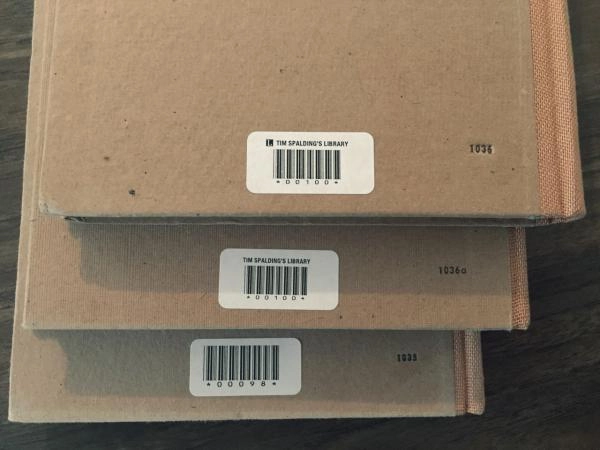
Labels on textbooks and laptops are made with durable materials so barcodes don’t fade or fall off (Mobile Barcode Scanners: Education) (Mobile Barcode Scanners: Education). The placement of barcodes (e.g. inside a book’s back cover rather than on the outside) is standardized to make scanning quicker and protect the code from wear (Frequently Asked Questions - AU Library Self Check Kiosk & App). On the administrative side, schools are crafting policies for barcode/QR usage, covering questions like: How do students without smartphones access QR-only resources? (Solution: always provide a short URL or alternative); What to do if an ID barcode won’t scan? (Have manual lookup as backup); How to handle lost ID cards with barcodes? (Deactivate the old barcode in the system immediately, similar to canceling a lost credit card). Finally, accessibility is an emerging concern. While QR codes are convenient for many, institutions are beginning to ensure that visually impaired students can still participate – for example, by providing NFC alternatives or embedding alt-text in digital materials to describe any QR code’s function. Universities are incorporating these considerations so that the tech serves everyone. The drive towards unified standards is exemplified by efforts like EduCode in some EU circles – a hypothetical idea of one education barcode standard for all assets and IDs, which could simplify vendor solutions and integration. While such a universal code isn’t reality yet, the collaboration across libraries and campuses suggests a continued move to harmonize how barcodes and 2D codes are used in education. In essence, the future will not only see more advanced uses of these codes, but smarter ways of managing them – balancing convenience with privacy, and innovation with inclusivity.
Final thoughts
Barcodes, QR codes, and other 2D codes have become the silent workhorses of the education sector. From their humble beginnings in library backrooms to their current presence on student phones and diplomas, they have continually adapted to the needs of schools and universities. In the US and Europe alike, these technologies improve efficiency – automating what used to be tedious manual processes – and enhance security, whether by verifying identities or protecting exam integrity. As we move forward, we can expect them to integrate with cutting-edge technologies like AI and blockchain, ensuring that educational institutions run smarter and safer. Yet, for all the high-tech trends, the core appeal of barcodes and QR codes remains their elegant simplicity: encoding information in a few stripes or squares that any scanner (or smartphone) can read in an instant. This simplicity, coupled with thoughtful implementation guided by emerging best practices, means barcodes and 2D codes will continue to be a foundational tool in education for years to come – connecting the physical and digital realms of learning with just a quick scan.
How can barKoder help you?
Easy Integration into Existing Systems
- Cross-Platform Compatibility: Whether a school uses native mobile apps, web-based portals, or frameworks like Flutter, the barKoder SDK offers integration options that require minimal coding overhead.
- Straightforward Setup: barKoder’s documentation typically includes sample implementations (e.g., scanning a Code 128 label on a textbook) that administrators or developers can adapt quickly. By dropping in a few lines of SDK code, an existing application can start reading barcodes without having to rebuild from scratch.
Example Scenario
A K–12 school or university that already has a mobile attendance app can integrate barKoder’s scanning module. Students simply present their ID (with a barcode) at the door, and a single SDK call captures and validates the data in real time.
2. High Accuracy and Speed
- Robust Scanning Engine: For educational contexts—libraries, high-volume check-ins, or large-scale exam distributions—fast, accurate scanning is critical. barKoder’s SDK is engineered to read codes (including faded or partly damaged ones) rapidly, reducing queue times and manual errors.
- Multiple Code Support: The SDK can handle various symbologies relevant to education:
- 1D Codes (Code 39, Code 128, UPC/EAN) for library books or asset tags.
- 2D Codes (QR, DataMatrix, PDF417) for ID cards, exam sheets, and digital credentials.
Example Scenario
A university library receives thousands of returns daily. Using barKoder’s SDK within a self-checkout app means students can scan barcodes with a smartphone camera—even under poor lighting—reliably logging each book in seconds.
3. Versatility for Common Education Use Cases
Library Management
- Self-Checkout: Integrate the SDK into a mobile or kiosk application so students can scan the book’s barcode themselves—streamlining service during busy periods.
- Inventory & Audits: Staff scan shelf items using a smartphone; the SDK updates the library database instantly, saving time in annual or semi-annual audits.
Student & Staff ID Systems
- Multi-Function ID Cards: Embed barKoder’s scanning engine in the campus app so scanning a QR code on the physical or digital ID automates building access, cafeteria payments, or attendance logging.
- Contactless Check-Ins: For events or orientation, simply generate QR codes for each participant and let barKoder’s SDK read them at entry.
Attendance Tracking
- Classroom Roll Call: A teacher’s device (tablet or phone) uses the SDK to scan student IDs quickly, recording attendance data in a database.
- Exam Sessions: By scanning printed barcodes on exam entry passes, staff instantly confirm which students are present, preventing impersonation.
Exam Security & Grading
- Unique Codes on Exam Sheets: The SDK can verify that each code matches an assigned student or seat, helping deter cheating and ensuring correct retrieval of completed papers.
- Speeding Up Grading: Linking each code to a student’s record ensures that staff or automated systems never misfile exam documents.
Asset & Equipment Tracking
- Textbook Distribution: A quick scan with the barKoder SDK ties each book’s ID to a student’s account, reducing end-of-year confusion and fines.
- Lab Equipment: Tagging microscopes, laptops, or other assets with codes read by the SDK fosters easy check-in/check-out, preventing loss and aiding maintenance scheduling.
4. Streamlined Development & Documentation
- Comprehensive Docs & Examples: barKoder typically provides step-by-step guides, sample code snippets (e.g., scanning a PDF417 code in a Flutter or React Native environment), and FAQ resources to reduce the learning curve for IT staff.
- API & Callbacks: The SDK often includes callback methods for when a barcode is successfully detected, which developers can hook into to trigger attendance updates or library checkouts.
Example Scenario
A European university that wants to build a new “campus companion” mobile app can embed the SDK to enable on-the-spot scanning for access control, attendance, event registration, and meal purchases—all from a single scanning module rather than multiple plugins.
5. Security & Privacy Considerations
- Data Minimization: barKoder’s SDK can be configured to return only the barcode data (like a student ID), leaving the full personal record in the institution’s secure database—important for FERPA, GDPR, or other privacy regulations.
- Encrypted/Offline Scanning: In secure exam scenarios, the SDK can read codes even offline, preventing the need to expose data over a network connection.
Example Scenario
During final exams, a school can operate in airplane mode, scanning each test booklet’s QR code to confirm distribution. The data syncs once the device reconnects, preserving exam integrity and meeting strict privacy rules.
6. Scalability and Future-Proofing
- Modular Upgrades: As an SDK, barKoder can roll out updates supporting new code types or advanced features (e.g., reading micro-QRs, offering AI-based detection of mislabeled items) without forcing the educational institution to overhaul its apps.
- Integration with Other Systems: Schools might pair barKoder with existing SIS (Student Information System) or library software. This makes it easy to automate workflows—once the scan is complete, data flows seamlessly into external platforms.
- Roadmap for Emerging Technologies: BarKoder can complement future-facing efforts like blockchain-based credentials or AI-driven analytics. The scanning engine remains the gateway to input data from physical codes into the digital realm.
Example Scenario
A new district-wide policy mandates all classroom devices must be barcoded for annual checkups. The school can simply create an additional scanning workflow in their mobile maintenance app—no new hardware needed, just the barKoder SDK update.
